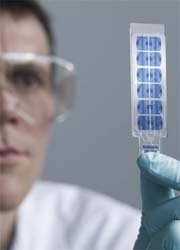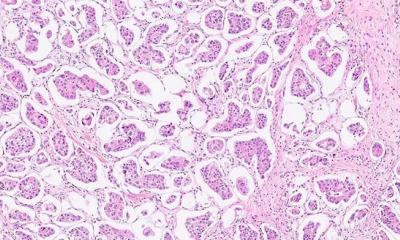Arrays to detect genomic disorder
Chromosomal rearrangements leading to genomic disorders are often mediated by low-copy repeat regions of the genome (e.g. segmental duplications)
Roche reports that, using its NimbleGen CGH arrays, researchers* have identified a recurrent reciprocal genomic rearrangement of chromosomal region 17q12 in foetal samples with congenital anomalies that is also associated with paediatric renal disease and epilepsy.

‘The results emphasize the importance of evaluating de novo structural variation events in paediatric diseases other than mental retardation and the importance of duplication architecture as a predisposing factor for disease,’ Roche points out.
Genomic disorders result from nonallelic homologous recombination (NAHR) between low-copy repeat regions of the genome and occur in approximately 1 in 1,000 live births. The phenotypes of many of these known genomic disorders include developmental delay and mental retardation. Therefore, screening for novel genomic disorders has largely focused on patients with cognitive disability and/or peripheral nervous system defects.
Previous studies reported on the development and use of a BAC-based microarray targeting 130 ‘rearrangement hotspots’, defined as regions of the genome with an architecture suggestive of a susceptibility to recurrent microdeletion and/or duplication. Employing this array, novel genomic disorders associated with mental retardation and developmental delay (MR/DD) were discovered. Surprisingly, many of the predicted 130 hotspot regions have never been associated with copy number variants in either apparently normal individuals or patients with MR/DD.
To address the hypothesis that genomic rearrangements mediated by many of these regions affect gene pathways other than those involved in MR/DD, and to broaden the spectrum of diseases caused by genomic disorders, H C Mefford and colleagues analysed DNA samples from prenatal autopsy specimens from 155 foetuses with one or more congenital anomalies, no known cytogenetic anomalies, and detailed pathology data were analysed by BAC array CGH.
According to the data, nine individuals (6 %) showed evidence of microdeletion or microduplication and eight were identified with potentially pathogenic deletions or duplications. Fine-mapping using a custom oligonucleotide array (NimbleGen, 385K, average probe spacing 53 bp) revealed that three of the individuals harbour microdeletions with breakpoints mapping to flanking segmental duplications. One foetus with bilateral multicystic dysplastic kidneys contained a deletion region of 1.8 Mb at 17q12 that involves 19 known genes. Mutations in one of these genes, TCF2, has been shown to cause maturity-onset diabetes of the young type 5 (MODY5) and both paediatric and prenatally detectable cystic renal disease. In one study, one third of MODY5-affected individuals exhibited deletion of the entire TCF2 gene and surrounding sequence.
Five patients with paediatric renal disease without diabetes and three patients with MODY5 previously shown to have deletions encompassing the TCF2 gene were analysed using a custom oligonucleotide array (NimbleGen, 385K, average probe spacing 53 bp). Four of five paediatric and all three of the MODY5 patients showed microdeletions nearly identical to the foetal case. In addition, Roche NimbleGen custom fine-tiling array CGH was used to identify the reciprocal microduplication in patients with mild-to-moderate mental retardation, epilepsy, and focal cortical dysplasia.
In summary, the analysis revealed novel microdeletions and duplications in a series of foetal samples with congenital anomalies other than mental retardation. The 17q12 deletion is the first genomic disorder identified that results in diabetes and the identification of this recurrent microdeletion will have a significant impact on diagnosis, prognosis, and management of renal disease and early-onset type II diabetes in children. Therefore, the evaluation of this microdeletion should be considered early in the diagnostic workup for children with renal pathology. In addition, the authors advocate generalised screening of genomic hotspot regions of both parents and offspring for other paediatric diseases for which the genetic aetiology is not well understood, including schizophrenia, asthma, and cardiovascular disease.
* Mefford HC et al.: Recurrent reciprocal genomic rearrangements of 17q12 are associated with renal disease, diabetes, and epilepsy Am J Hum Genet 2007; 81: 1057-1069
01.09.2008











